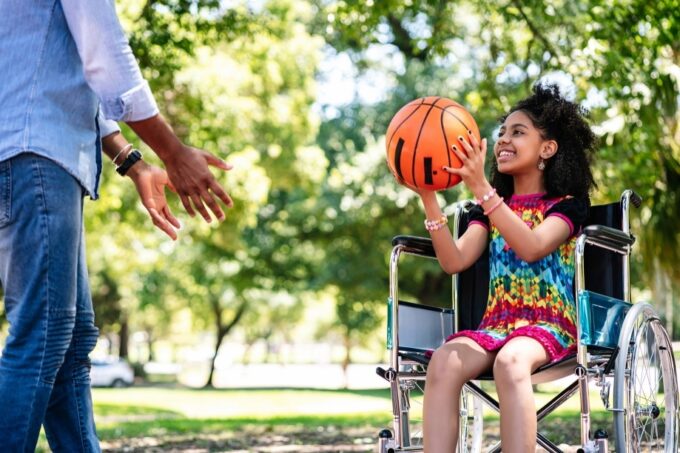Introduction
Every child deserves the chance to play, move, and feel included. However, children with neurodisabilities often face challenges that limit participation in traditional sports. This is where Adaptive Sports play a transformative role. By modifying rules, equipment, and environments, these sports ensure inclusivity while supporting children’s physical, emotional, and social development.
Through structured programs, children not only build strength and mobility but also experience joy, teamwork, and self-expression. This blog explores the significance of Adaptive Sports, their benefits, types of activities, and practical ways families and communities can engage children with neurodisability.
Why Adaptive Sports Matter
Unlike conventional sporting activities, Adaptive Sports are carefully designed to accommodate varying abilities. They encourage children to focus on what they can achieve, instead of what they cannot. These programs often lead to:
-
Improved physical fitness, balance, and coordination
-
Increased confidence and independence
-
Enhanced social connections through teamwork
-
Better mental well-being through play and achievement
Furthermore, these activities create an environment of inclusivity, where children learn to interact without the barriers of stigma or limitation.
Key Benefits of Adaptive Sports
While physical fitness is an obvious outcome, the holistic benefits of Adaptive Sports extend much further:
1. Physical Growth and Mobility
Participation enhances muscle strength, endurance, and fine motor skills. For children with neurodisabilities, it helps manage spasticity, improves flexibility, and boosts cardiovascular health.
2. Emotional Resilience
Sports can be therapeutic, offering children a way to manage frustration and anxiety. Success on the field or court often translates to improved self-esteem.
3. Social Interaction
Children build friendships and teamwork skills, fostering a sense of belonging. These experiences prepare them for social situations outside of sports as well.
4. Cognitive Development
Engaging in strategy-based games sharpens problem-solving, attention, and memory. This cognitive stimulation is especially valuable for children managing neurodisability-related challenges.
Popular Adaptive Activities for Children
There is a wide range of activities tailored to different needs and preferences. Some accessible and popular Adaptive Sports include:
-
Wheelchair Basketball – Builds teamwork, upper-body strength, and coordination.
-
Swimming – Improves cardiovascular health, flexibility, and relaxation while reducing joint stress.
-
Boccia – A precision sport similar to bocce ball, suitable for children with limited mobility.
-
Adaptive Cycling – Uses specially designed tricycles or hand cycles to enhance balance and endurance.
-
Horseback Riding (Equine Therapy) – Encourages posture control, balance, and emotional bonding with animals.
-
Track and Field – Modified races or throwing activities designed to match individual ability levels.
These activities not only adapt to children’s physical needs but also open doors to experiencing the thrill of sports in inclusive environments.
Supporting Families and Communities
Families play a vital role in encouraging children to participate. However, communities must also provide the right resources, facilities, and inclusive spaces. To make Adaptive Sports a sustainable part of childhood experiences, we must:
-
Increase awareness through schools and healthcare providers
-
Develop safe, accessible sporting venues
-
Provide professional trainers who specialize in neurodisabilities
-
Build partnerships with rehabilitation centers and support groups
When children see their families and communities actively involved, they feel empowered to step forward and engage without hesitation.
Overcoming Barriers
While opportunities exist, families often face obstacles such as limited facilities, lack of trained instructors, or financial challenges. Nevertheless, progress is being made globally and locally. Organizations and health specialists are working toward funding, advocacy, and awareness to ensure that every child, regardless of their abilities, has access to enriching activities.
Furthermore, technology has introduced innovative solutions like virtual reality simulations, customized equipment, and mobile apps that encourage at-home practice, making participation more accessible than ever before.
Tips for Parents Encouraging Participation
Parents can help children feel comfortable and motivated in Adaptive Sports by following practical steps:
-
Start small, with short and enjoyable sessions.
-
Allow children to choose activities that interest them.
-
Celebrate achievements, no matter how small.
-
Collaborate with therapists, coaches, and teachers for a consistent approach.
-
Prioritize fun and enjoyment over competition.
By focusing on progress rather than perfection, children are more likely to remain engaged and enthusiastic.
Expert Insights
Medical professionals and therapists often highlight the importance of individualized approaches. According to specialists like Dr. Vivek Mundada, each child’s physical and cognitive abilities should guide the choice of sport. Structured evaluations ensure that activities remain safe, supportive, and developmentally appropriate.
Conclusion
In essence, Adaptive Sports are not just about physical exercise—they are about opening doors to inclusion, empowerment, and growth. They provide children with opportunities to thrive physically, emotionally, and socially, while giving families hope and support. With rising awareness and community engagement, these activities are becoming increasingly accessible, creating brighter futures for children with unique challenges.
By focusing on adaptive sports for neurodisability, families can embrace inclusive opportunities under the guidance of experts like a paediatric neurologist in Dubai, ensuring that every child receives the chance to play, grow, and succeed.
FAQs
1. What are Adaptive Sports?
Adaptive Sports are specially modified physical activities designed to make participation possible for children and adults with disabilities. They adjust rules, equipment, or techniques to suit individual needs.
2. Who can participate in Adaptive Sports?
Any child with a physical, sensory, or cognitive neurodisability can participate. Sports are tailored to their abilities, ensuring safety and inclusivity.
3. How can parents find local programs?
Parents can reach out to hospitals, therapy centers, rehabilitation groups, or community organizations that collaborate with adaptive programs. Some schools also integrate inclusive sports into their curriculum.



